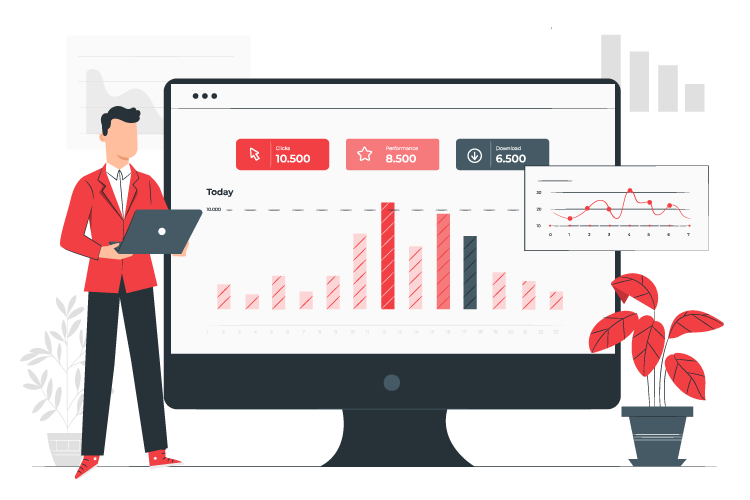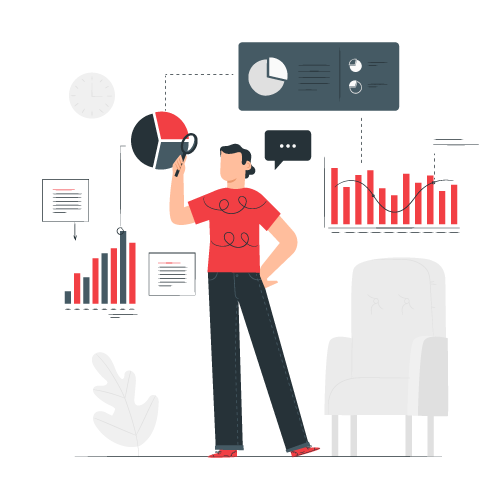HR guide
Chapter 09
Reporting and analytics
In today’s data-driven world, HR professionals need to rely on accurate and reliable data to make strategic business decisions. This chapter will explore the importance of HR reporting and analytics, key metrics to track, tools and techniques, best practices, common challenges, and how to use HR reporting and analytics to drive business results.

Why HR reporting and analytics matter
HR Reporting and Analytics are critical tools for Human Resources (HR) professionals in managing their organization’s workforce. With the increasing importance of data-driven decision-making, HR professionals must have access to accurate and timely HR data to make informed decisions about their workforce.
Here are some reasons why HR Reporting and Analytics matter:
Provides insightful data: HR Reporting and Analytics provide HR professionals with insightful data about their organization’s workforce, including employee demographics, retention rates, turnover rates, absenteeism, and many more. This information helps them identify areas that need improvement and develop strategies to address them.
Helps measure HR performance: HR Reporting and Analytics help HR professionals measure their department’s performance, including their recruitment process, employee engagement, performance management, and compliance with labor laws. These metrics enable HR professionals to assess the effectiveness of their initiatives and make data-driven decisions to improve their HR processes.
Enables better decision making: HR Reporting and Analytics provide HR professionals with real-time data that they can use to make better decisions about their workforce. For example, they can use this data to identify high-performing employees and reward them accordingly or identify low-performing employees and develop a plan to improve their performance.
Helps identify trends: HR Reporting and Analytics help HR professionals identify trends within their workforce, such as turnover rates, employee satisfaction, and engagement levels. This information enables them to develop strategies to address these trends and improve their organization’s overall performance.
Enhances compliance: HR Reporting and Analytics help HR professionals ensure their organization is compliant with labor laws and regulations. They can use these tools to monitor compliance with employment laws, such as minimum wage, overtime, and discrimination laws, and ensure their organization is not at risk of legal action.
Key metrics to track in HR reporting and analytics
There are several key metrics that HR professionals should track in HR reporting and analytics to measure the effectiveness of their HR processes and make data-driven decisions. Here are some examples:
Employee turnover rate: This metric measures the percentage of employees who leave the organization during a specific period. A high turnover rate may indicate issues with employee engagement, management, or compensation.
Time-to-fill: This metric measures the time it takes to fill a vacant position, from the job posting to the new hire’s start date. A long time to fill may indicate issues with the recruitment process, such as a lack of qualified candidates or a slow hiring process.
Employee satisfaction/engagement: This metric measures how satisfied and engaged employees are in their work. It can be measured through surveys, focus groups, or other feedback mechanisms. High employee satisfaction and engagement are associated with better productivity and retention.
Absenteeism: This metric measures the percentage of scheduled work time that employees miss due to unplanned absences. High absenteeism may indicate issues with employee engagement, health, or work-life balance.
Diversity and inclusion: This metric measures the organization’s diversity and inclusion efforts, such as the representation of different demographic groups, employee resource groups, or training programs. Diversity and inclusion are essential for building a strong and inclusive culture and attracting and retaining diverse talent.
Training and development: This metric measures the organization’s investment in employee training and development programs. This metric can include the percentage of employees who received training, the number of training hours, or the impact of training on employee performance.
Compliance: This metric measures the organization’s compliance with labor laws and regulations, such as minimum wage, overtime, and anti-discrimination laws. Non-compliance can result in legal and financial consequences.

Tools and techniques for HR reporting and analytics
analytics. Here are some examples:
HR Information Systems (HRIS): An HRIS is a software system that enables HR professionals to collect, store, and manage HR data. An HRIS can automate HR processes, such as payroll and benefits administration, and generate reports on HR metrics, such as employee turnover rates and time-to-fill.
Business intelligence (BI) tools: BI tools enable HR professionals to analyze and visualize HR data and generate reports and dashboards. BI tools can help HR professionals identify patterns, trends, and insights in HR data and make data-driven decisions.
Predictive analytics: Predictive analytics is a technique that uses statistical models and machine learning algorithms to predict future outcomes based on historical data. HR professionals can use predictive analytics to forecast employee turnover, identify high-performing employees, and predict future hiring needs.
Surveys and feedback mechanisms: Surveys and feedback mechanisms, such as focus groups and one-on-one interviews, enable HR professionals to collect qualitative data on employee satisfaction, engagement, and performance. This data can supplement quantitative data from HRIS and BI tools and provide a more comprehensive view of the workforce.
Benchmarking: Benchmarking is a process of comparing an organization’s HR metrics with industry benchmarks or best practices. HR professionals can use benchmarking to identify areas of improvement and set targets for improvement.
Data visualization: Data visualization is a technique that uses charts, graphs, and other visual aids to represent HR data. Data visualization can help HR professionals communicate complex data to stakeholders more effectively and identify patterns and trends in HR data.
Best practices for HR reporting and analytics
ere are some best practices for HR reporting and analytics:
Identify Key metrics: Define the key metrics that align with your organization’s strategic objectives and goals. These metrics should be measurable, relevant, and aligned with your organization’s mission and values.
Use reliable data sources: Ensure that the data sources used for reporting and analytics are reliable and accurate. This data can be collected from HRIS, surveys, or other sources.
Standardize data: Standardize the data collected to ensure consistency and accuracy. This includes data such as job titles, job levels, and performance ratings.
Use data visualization: Use data visualization techniques such as charts, graphs, and dashboards to make HR data more accessible and understandable to stakeholders.
Share results: Share HR reporting and analytics results with stakeholders such as management, employees, and HR team members. This helps to ensure transparency and accountability.
Incorporate feedback: Incorporate feedback from stakeholders and HR team members to continuously improve HR reporting and analytics processes.
Analyze trends: Analyze trends in HR data over time to identify patterns and insights. This helps to identify areas of improvement and make data-driven decisions.
Be proactive: Use HR reporting and analytics to identify potential HR issues before they become problems. This includes identifying high-performing employees and those at risk of leaving the organization.
Focus on Continuous Improvement: Continuously review and improve HR reporting and analytics processes to ensure they align with the organization’s goals and objectives.

Common challenges in HR reporting and analytics
HR reporting and analytics can provide valuable insights into an organization’s workforce, but there are several challenges that HR professionals may face. Here are some common challenges in HR reporting and analytics:
Data quality: One of the biggest challenges in HR reporting and analytics is ensuring data quality. HR data can come from different sources and can be inconsistent, incomplete, or inaccurate, which can affect the reliability and validity of the analysis.
Data security: HR data contains sensitive information, such as employee personal information and compensation data. It is important to ensure that HR data is secure and protected from unauthorized access.
Technology infrastructure: HR reporting and analytics requires a robust technology infrastructure, such as HRIS, BI tools, and data storage. It can be challenging for organizations to invest in and maintain this infrastructure.
Data integration: HR data can be stored in multiple systems, such as payroll, benefits, and performance management. Integrating data from these systems can be challenging and time-consuming.
Data interpretation: Analyzing HR data requires advanced analytical skills and a deep understanding of HR metrics and data visualization. HR professionals may require additional training and development to interpret and analyze data effectively.
Change management: Implementing HR reporting and analytics can require significant organizational change, including changes to HR processes, systems, and culture. Resistance to change can be a significant challenge for HR professionals.
Lack of executive buy-in: HR reporting and analytics requires the support and buy-in of executive leadership to be effective. Without executive buy-in, HR reporting and analytics may not receive the necessary resources or support to be successful.
How to use HR reporting and analytics to drive business results
HR reporting and analytics can provide valuable insights into an organization’s workforce and help HR professionals make data-driven decisions that drive business results. Here are some ways to use HR reporting and analytics to drive business results:
Identify high-performing employees: HR reporting and analytics can help identify high-performing employees who can contribute to the organization’s strategic goals. This can include identifying employees with unique skills, experience, or potential for growth.
Improve employee engagement: HR reporting and analytics can help identify factors that contribute to employee engagement, such as job satisfaction, compensation, and career development. By addressing these factors, organizations can improve employee engagement and retention.
Identify skills gaps: HR reporting and analytics can help identify skills gaps in the workforce and develop targeted training and development programs to fill those gaps. This helps ensure that employees have the necessary skills to achieve the organization’s strategic goals.
Monitor diversity and inclusion: HR reporting and analytics can help monitor and improve diversity and inclusion in the workplace. This includes tracking metrics such as gender, race, and ethnicity and developing strategies to promote diversity and inclusion.
Improve talent acquisition: HR reporting and analytics can help identify effective recruitment channels and develop targeted recruitment strategies to attract top talent. This helps ensure that organizations have the right talent to achieve their strategic goals.
Monitor performance: HR reporting and analytics can help monitor employee performance and identify opportunities for improvement. This includes tracking metrics such as performance ratings, productivity, and attendance.
Optimize workforce planning: HR reporting and analytics can help organizations optimize workforce planning by identifying workforce needs, forecasting future needs, and developing strategies to address those needs.
Examples of HR reporting and analytics in action
HR reporting and analytics can provide valuable insights into an organization’s workforce and help HR professionals make data-driven decisions that drive business results. Here are some examples of HR reporting and analytics in action:
Employee turnover: HR reporting and analytics can help organizations track employee turnover rates and identify the reasons why employees are leaving. By analyzing this data, organizations can develop targeted retention strategies to address the underlying causes of turnover and improve employee retention.
Performance management: HR reporting and analytics can help organizations track and analyze employee performance metrics, such as productivity, quality, and attendance. By analyzing this data, organizations can identify trends and patterns that can inform performance management strategies, such as coaching, training, and performance improvement plans.
Diversity and inclusion: HR reporting and analytics can help organizations track and analyze diversity and inclusion metrics, such as gender, race, and ethnicity. By analyzing this data, organizations can identify gaps and develop targeted strategies to promote diversity and inclusion in the workplace.
Talent acquisition: HR reporting and analytics can help organizations track and analyze recruitment metrics, such as time-to-fill, cost-per-hire, and source-of-hire. By analyzing this data, organizations can identify effective recruitment channels and develop targeted recruitment strategies to attract top talent.
Workforce planning: HR reporting and analytics can help organizations track and analyze workforce metrics, such as headcount, turnover, and skills gaps. By analyzing this data, organizations can identify workforce needs, forecast future needs, and develop strategies to address those needs.
Employee engagement: HR reporting and analytics can help organizations track and analyze employee engagement metrics, such as job satisfaction, communication, and recognition. By analyzing this data, organizations can identify factors that contribute to employee engagement and develop targeted strategies to improve engagement.

